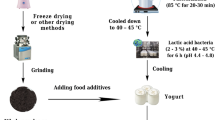Abstract
The effects of Ku Ding tea (Lactuca taiwaniana Maxim) and milk powder on biochemical and immunological parameters of Sprague-Dawley rats were investigated and the possibility of use of Ku Ding tea to reduce physiological discomfort of drinking milk powder was assessed. Eighty rats were randomly assigned to four treatments: basal diet (control), basal diet plus whole milk powder (WM), basal diet plus Ku Ding tea (KD) and basal diet plus whole milk powder and Ku Ding tea (MK). Data was collected on animals’ final body weight, hematological values, blood biochemical parameters, antioxidation parameters and immune organ weight index. Results showed that final body weight of male KD was significantly lower than that of WM. White blood cell count, monocyte count and granulocyte count of KD rats were significantly lower than those of WM. Compared to the control, single milk powder supplementation numerically increased plasma malondialdehyde. The malondialdehyde in the male KD and MK rats were lower than those in WM and control, although the differences were not significant. No significant differences were found in Na+K+-adenosine triphosphatase activity, spleen and thymus index in each group. Consumption of Ku Ding tea appeared to lower lipid peroxidation that was induced by milk powder in the rats.

Similar content being viewed by others
References
Anon (1989) Physical and chemical analysis of tea quality. Hangzhou Tea Processing Research Institute, Ministry of Commerce, Shanghai Science and Technology Press, Shanghai
Bay BH, Lee YK, Tan BK, Ling EA (1999) Lipid peroxidative stress and antioxidative enzymes in brains of milk-supplemented rats. Neurosci Lett 277:127–130
Bricarello LP, Kasinski N, Bertolami MC, Faludi A, Pinto LA, Relvas WG, Izar MC, Ihara SS, Tufik S, Fonseca FA (2004) Comparison between the effects of soy milk and non-fat cow milk on lipid profile and lipid peroxidation in patients with primary hypercholesterolemia. Nutrition 20:200–204
Heck CI, Mejia EG (2007) Yerba mate tea (Ilex paraguariensis): A comprehensive review on chemistry, health implication, and technological consideration. J Food Sci 72:R138–R151
Horie K, Miyata T, Maeda K, Miyata S, Sugiyama S, Sakai H, Van Ypersole de Strihou C, Monnier VM, Witztum JL, Kurokawa K (1997) Immunohistochemical colocalization of glycoxidation products and lipid peroxidation products in diabetic renal glomerular lesions. Implication for glycoxidative stress in the pathogenesis of diabetic nephropathy. J Clin Invest 100:2995–3004
Horisberger J, Lemas V, Kraehenbuhl J, Rossier BC (1991) Structure-Function Relationship of Na, K-ATPase. Annu Rev Physiol 53:565–584
Hseu YC, Chang WH, Chen CS, Liao JW, Huang CJ, Lu FU, Chia YC, Hsu HK, Wu JJ, Yang HL (2008) Antioxidant activities of Toona Sinensis leaves extracts using different antioxidant models. Food Chem Toxicol 46:105–114
Huth PJ, DiRienzo DB, Miller GD (2006) Major scientific advances with dairy foods in nutrition and health. J Dairy Sci 89:1207–1221
Lau KM, He ZD, Dong H, Fung KP, But PPH (2002) Anti-oxidative, anti-inflammatory and hepato-protective effects of Ligustrum robustum. J Ethnopharmacol 83:63–71
Liu LX, Sun Y, Laura T, Liang XF, Ye H, Zeng XX (2009) Determination of polyphenolic content and antioxidant activity of kudingcha made from Ilex kudingcha C.J. Tseng. Food Chem 112:35–41
MacDonald HB (2008) Dairy nutrition: What we knew then to what we know now. Int Dairy J 18:774–777
McCord JM (2000) The evolution of free radicals and oxidative stress. Am J Med 108:652–959
Michaelidou AM (2008) Factors influencing nutritional and health profile of milk and milk products. Small Rum Res 79:42–50
Miki M, Tamai H, Mino M, Yamamoto Y, Niki E (1987) Free radical chain oxidation of rat red blood cells by molecular oxygen and its inhibition by Alpha-tocopherol. Arch Biochem Biophys 258:373–380
Nishimura K, Fukuda T, Miyase T, Noguchi H, Chen XM (1999a) Activity-guided isolation of triterpenoid acyl CoA cholesteryl acyl transferase (ACAT) inhibitors from Ilex Kudingcha. J Nat Prod 62:1061–1064
Nishimura K, Miyase T, Noguchi H (1999b) Triterpenoid saponins from Ilex Kudincha. J Nat Prod 62:1128–1133
Pan HJ, Liao ZY, Ying QC, Tian JW, Xu Y (2004) Study on lipid-depressing function of kuding tea prepared from Ilex latifolia Thunb leaves. J Tea Sci 24:49–52
Ren GP, Zhang RM, Peng C, Li B, Dai ZY (2003) Mechanism of cow milk Shang huo. China Dairy 11:17–19
Saxelin M, Korpela R, Mayra-Makinen A (2003) Introduction: classifying functional dairy products. In: Mattila-Sandholm T, Saarela M (eds) functional dairy products. Woodhead Publ Ltd, Cambridge, pp 1–16
Subhuti D 2002. Imtonline Article ‘KU DING CHA’. Institute for Traditional Medicine, Oregon, Portland. Available from: http://www.itmonline.org/arts/kudingcha.htm. Accessed Nov 16, 2008
Tam CF, Peng Y, Liang ZT, He ZD, Zhao ZZ (2006) Application of microscopic techniques in authentication of herbal tea-Ku-Ding-Cha. Microsc Res Tech 69:927–932
Tarladgis BG, Natts BM, Younathan MT, Durgan L Jr (1960) A distillation method for quantitative determination of malonaldehyde in foods. J Am Oil Chemists Soc 37:44–48
Thuong PT, Su ND, Ngoc TM, Hung TM, Dang NH, Thuan ND, Bae KH, Oh WK (2009) Antioxidant activity and principles of Vietnam bitter tea Ilex kudingcha. Food Chem 113:139–145
Zheng J (2003) Experimental study on the antiobese effect of Kudingcha total terpene. MS Thesis, Department of Pharmacology, Hunan College of Traditional Chinese Medicine, Changsha, Hunan, China
Zheng L, Zhou WJ (2005) Discussion on Mechanism of ‘Shanghuo’ (Upper Feaver) and Milk Powder Induced ‘Shanghuo’. Guangdong Weiliang Yuansu Kexue 12:63–64
Acknowledgements
Authors express this sincere gratitude and appreciation to the Ministry of Science and Technology of China (2006BAD04A15) for providing the financial support for this study.
Author information
Authors and Affiliations
Corresponding author
Rights and permissions
About this article
Cite this article
Xiao, W.J., Han, X.F., Tan, Z.L. et al. Milk powder induced lipid peroxidation reduction using Ku Ding tea (Lactuca taiwaniana Maxim) in rats. J Food Sci Technol 48, 447–453 (2011). https://doi.org/10.1007/s13197-010-0192-0
Revised:
Accepted:
Published:
Issue Date:
DOI: https://doi.org/10.1007/s13197-010-0192-0




